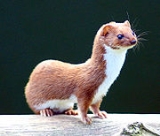
Least Weasel
Overview
The least weasel is the smallest member of the Mustelidae
(as well as the smallest of the Carnivora
), native to Eurasia
, North America
and North Africa
, though it has been introduced elsewhere. It is classed as Least Concern
by the IUCN, due to its wide distribution and presumably large population. Despite its small size, the least weasel is a fierce hunter, capable of killing a rabbit
5-10 times its own weight.
Within the genus Mustela, the least weasel is a relatively unspecialised form, as evidenced by its pedomorphic skull, which occurs even in large subspecies.
Mustelidae
Mustelidae , commonly referred to as the weasel family, are a family of carnivorous mammals. Mustelids are diverse and the largest family in the order Carnivora, at least partly because in the past it has been a catch-all category for many early or poorly differentiated taxa...
(as well as the smallest of the Carnivora
Carnivora
The diverse order Carnivora |Latin]] carō "flesh", + vorāre "to devour") includes over 260 species of placental mammals. Its members are formally referred to as carnivorans, while the word "carnivore" can refer to any meat-eating animal...
), native to Eurasia
Eurasia
Eurasia is a continent or supercontinent comprising the traditional continents of Europe and Asia ; covering about 52,990,000 km2 or about 10.6% of the Earth's surface located primarily in the eastern and northern hemispheres...
, North America
North America
North America is a continent wholly within the Northern Hemisphere and almost wholly within the Western Hemisphere. It is also considered a northern subcontinent of the Americas...
and North Africa
North Africa
North Africa or Northern Africa is the northernmost region of the African continent, linked by the Sahara to Sub-Saharan Africa. Geopolitically, the United Nations definition of Northern Africa includes eight countries or territories; Algeria, Egypt, Libya, Morocco, South Sudan, Sudan, Tunisia, and...
, though it has been introduced elsewhere. It is classed as Least Concern
Least Concern
Least Concern is an IUCN category assigned to extant taxon or lower taxa which have been evaluated but do not qualify for any other category. As such they do not qualify as threatened, Near Threatened, or Conservation Dependent...
by the IUCN, due to its wide distribution and presumably large population. Despite its small size, the least weasel is a fierce hunter, capable of killing a rabbit
Rabbit
Rabbits are small mammals in the family Leporidae of the order Lagomorpha, found in several parts of the world...
5-10 times its own weight.
Within the genus Mustela, the least weasel is a relatively unspecialised form, as evidenced by its pedomorphic skull, which occurs even in large subspecies.

